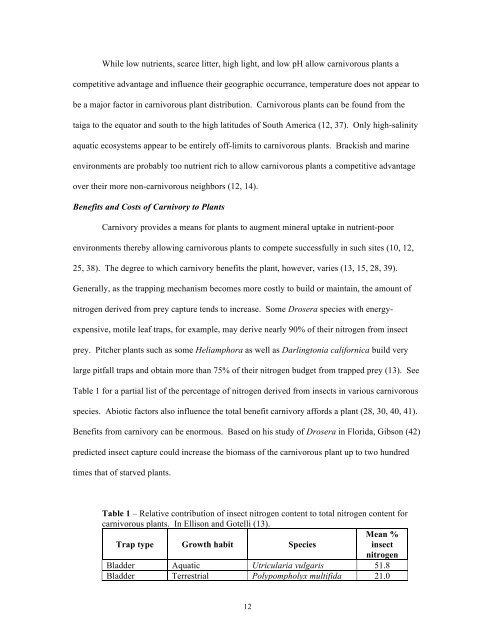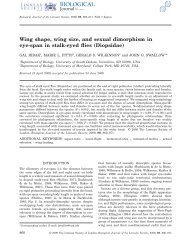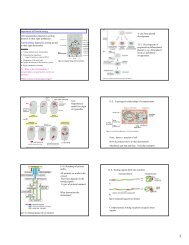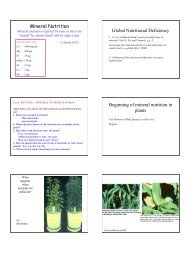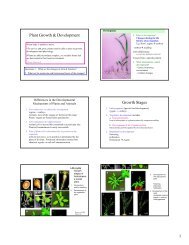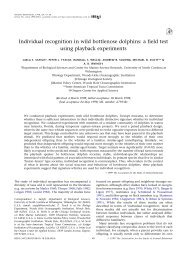Carnivorous Plants and Their Prey
Carnivorous Plants and Their Prey
Carnivorous Plants and Their Prey
Create successful ePaper yourself
Turn your PDF publications into a flip-book with our unique Google optimized e-Paper software.
While low nutrients, scarce litter, high light, <strong>and</strong> low pH allow carnivorous plants a<br />
competitive advantage <strong>and</strong> influence their geographic occurrance, temperature does not appear to<br />
be a major factor in carnivorous plant distribution. <strong>Carnivorous</strong> plants can be found from the<br />
taiga to the equator <strong>and</strong> south to the high latitudes of South America (12, 37). Only high-salinity<br />
aquatic ecosystems appear to be entirely off-limits to carnivorous plants. Brackish <strong>and</strong> marine<br />
environments are probably too nutrient rich to allow carnivorous plants a competitive advantage<br />
over their more non-carnivorous neighbors (12, 14).<br />
Benefits <strong>and</strong> Costs of Carnivory to <strong>Plants</strong><br />
Carnivory provides a means for plants to augment mineral uptake in nutrient-poor<br />
environments thereby allowing carnivorous plants to compete successfully in such sites (10, 12,<br />
25, 38). The degree to which carnivory benefits the plant, however, varies (13, 15, 28, 39).<br />
Generally, as the trapping mechanism becomes more costly to build or maintain, the amount of<br />
nitrogen derived from prey capture tends to increase. Some Drosera species with energy-<br />
expensive, motile leaf traps, for example, may derive nearly 90% of their nitrogen from insect<br />
prey. Pitcher plants such as some Heliamphora as well as Darlingtonia californica build very<br />
large pitfall traps <strong>and</strong> obtain more than 75% of their nitrogen budget from trapped prey (13). See<br />
Table 1 for a partial list of the percentage of nitrogen derived from insects in various carnivorous<br />
species. Abiotic factors also influence the total benefit carnivory affords a plant (28, 30, 40, 41).<br />
Benefits from carnivory can be enormous. Based on his study of Drosera in Florida, Gibson (42)<br />
predicted insect capture could increase the biomass of the carnivorous plant up to two hundred<br />
times that of starved plants.<br />
Table 1 – Relative contribution of insect nitrogen content to total nitrogen content for<br />
carnivorous plants. In Ellison <strong>and</strong> Gotelli (13).<br />
Mean %<br />
Trap type Growth habit<br />
Species<br />
insect<br />
nitrogen<br />
Bladder Aquatic Utricularia vulgaris 51.8<br />
Bladder Terrestrial Polypompholyx multifida 21.0<br />
12


